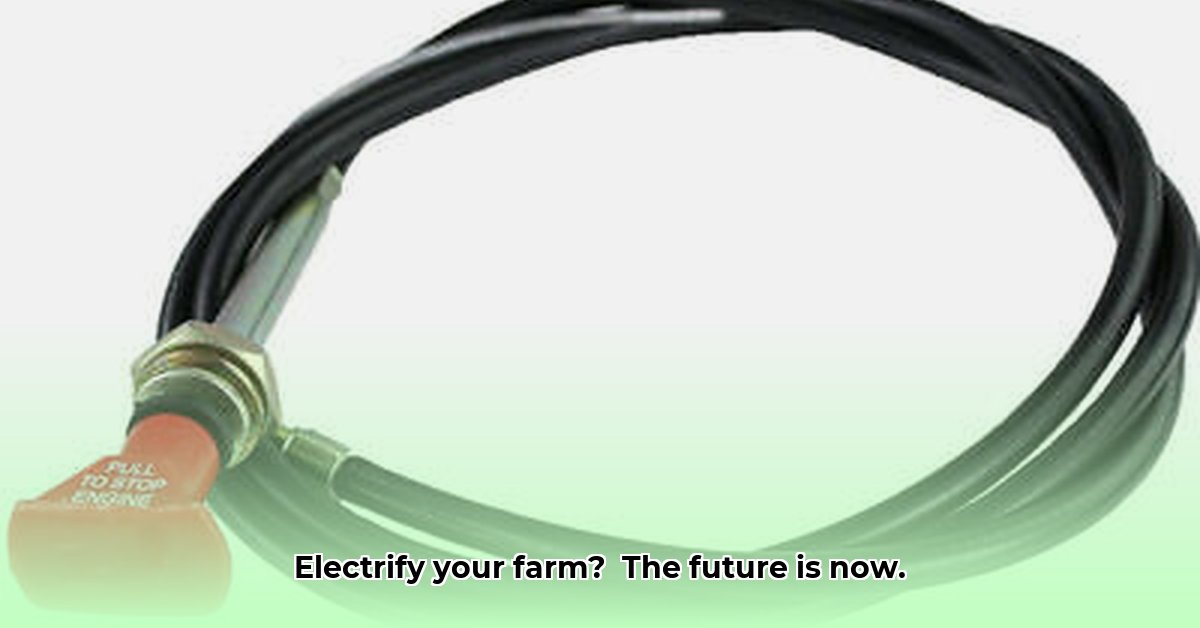
Tractor Supply Cable: Powering a Sustainable Farming Future
Electrifying your farm isn't just a trend; it's a strategic move towards a more sustainable and profitable future. The shift to electric tractors and equipment reduces your carbon footprint and often lowers operating costs. But even the most advanced electric machinery relies on a robust power supply—and that's where tractor supply cables become critical. These unsung components are the vital link between your farm's power sources and its electrically powered tools and machinery. They are the silent workhorses ensuring smooth, safe operation of everything from electric fencing to precision irrigation and robotic harvesters. For more information on cables, check out this helpful resource.
More Than Just Wires: Why Cable Quality Matters
While we often focus on the visible technology, the cables powering it are equally important. A reliable power supply is the bedrock of a successful electrified farm. Substandard cables risk downtime, equipment damage, and even safety hazards. Investing in high-quality cables is investing in the long-term reliability and operational efficiency of your entire farm. A farmer's livelihood depends on consistent performance, and that hinges on a well-maintained electrical system.
Choosing the Right Cable: A Practical Guide
Selecting the correct cable isn't arbitrary; it's a strategic decision directly impacting farm efficiency and safety. These considerations are key:
Gauge (AWG): This number indicates the cable's thickness and current-carrying capacity. Lower numbers (e.g., 6 AWG) signify thicker, higher-capacity cables suitable for high-wattage equipment like electric tractors. Higher numbers (e.g., 18 AWG) represent thinner cables for lower-power applications. Using an undersized cable for a high-demand tool causes overheating, leading to potential fire risk and equipment damage.
Insulation Material: Farm environments are harsh. Choose cables with durable, weatherproof insulation resistant to sunlight, rain, mud, and accidental impacts from machinery. Materials designed for outdoor use ensure longevity and reduce replacement costs.
Cable Length: Precise measurement is vital. Cables that are too short necessitate dangerous extension cords, while excessively long cables waste resources and increase resistance, reducing efficiency. Accurate measurement prevents both issues.
Application Specifics: Different applications have different needs. Heavy-duty equipment requires cables rated for high amperage and voltage, while sensitive electronic instruments need specialized cables to prevent damage. Consult supplier specifications to ensure compatibility.
From Struggles to Success: A Farmer's Story
Old McDonald (name changed for privacy), a conventional farmer who transitioned to electric equipment, initially faced challenges. He initially used inadequate extension cords, resulting in frequent power disruptions and near misses. After seeking advice from a qualified electrician, he invested in heavy-duty cables suitable for his high-wattage equipment. This resulted in significant improvements in reliability and safety. "The difference was night and day," McDonald stated. "The new cables eliminated the constant fear of equipment failure and electrical hazards." This significantly improved his productivity and saved him time and money spent on repairs.
The Financial and Environmental Payoff
While the initial investment in electric equipment and infrastructure can be substantial, the long-term benefits are compelling. Reduced fuel costs, lower maintenance due to reduced wear and tear, and potential government incentives can offset the upfront expenditure. Moreover, significantly reduced greenhouse gas emissions contribute to environmental sustainability, a growing concern for consumers and a strategic advantage in the marketplace.
Isn't it worth considering these long-term benefits?
The financial figures depend on your specific operation, but many farmers report significant savings within a few years of switching to electric equipment and proper cabling.
Building a Reliable and Safe Electrical System
Maintaining a robust and safe electrical system requires proactive measures:
Regular Inspections: Regularly inspect cables for wear, damage, or signs of overheating. Promptly replace any damaged cables. Simple inspections can prevent costly equipment failures and catastrophic events.
Professional Installation: Professional installation ensures safety compliance and avoids potentially hazardous situations. Professional electricians are trained to assess the specific needs of agricultural electrical systems.
Surge Protection: Power surges can severely damage electronics. Invest in surge protection devices to safeguard your investment. This is a small cost compared to replacing damaged equipment.
How to Finance Sustainable Agriculture Infrastructure Upgrades
Electrification represents a significant investment. Securing the necessary funds requires a strategic approach.
Understanding Your Financing Needs
Begin with a detailed budget outlining all equipment and infrastructure upgrades, including cabling. This comprehensive assessment clarifies your funding requirements.
Exploring Financing Options
Several funding avenues exist:
USDA Loans: The USDA offers various programs for farmers seeking funding for equipment, land, and sustainable practices. These loans often feature lower interest rates and subsidies.
Private Lender Loans: Private lenders may offer farm improvement loans with competitive interest rates and flexible terms. Carefully compare options from multiple lenders.
Grants & Cost-Share Programs: State and federal grants and cost-share programs can partially fund specific projects. Research programs relevant to your location and specific needs. These programs often come with requirements to follow certain sustainable practices.
A Practical Example: Electrifying the Dairy
Sarah, a dairy farmer upgrading to electric milking equipment, combined a USDA loan with a private lender loan to manage the costs. This blended approach enabled her to successfully switch to sustainable, efficient equipment.
Key Takeaways:
- Research all available funding options before making a decision.
- Understand each program's eligibility criteria.
- Don't overlook grants and cost-share programs to reduce overall costs.
- Develop a detailed budget to determine your funding requirements.
- Seek guidance from agricultural consultants or financial advisors.
By investing in proper cabling, farmers can maximize the efficiency, safety, and profitability of their operations while contributing to a more sustainable future. The initial cost is an investment that pays off in the long run, both environmentally and financially.